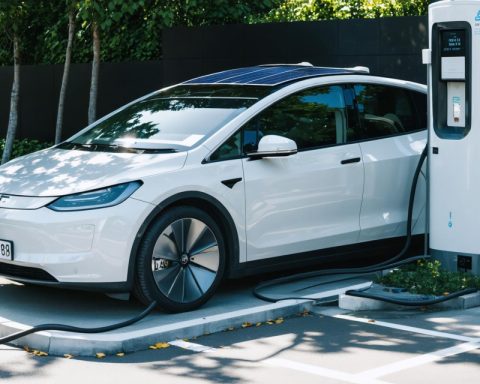- Floating solar farms revolutionize clean energy by utilizing underused water surfaces to generate power efficiently.
- These systems provide an innovative solution for land-scarce regions, leveraging existing water bodies to enhance energy capacity.
- Floating solar panels stay cooler on water, boosting efficiency and extending operational lifespan while reducing maintenance costs.
- Environmental benefits include reduced water evaporation and algae growth, aiding water conservation and ecosystem balance.
- Already successful in countries like Japan, China, and India, floating solar farms support carbon neutrality commitments.
- These installations symbolize the fusion of nature and technology, offering insights into sustainable energy practices.
Vast expanses of tranquil water bodies often hide static mysteries—until now. The modern energy landscape paints a picture of innovation with floating solar farms, the shining future of clean energy. This groundbreaking technology not only harnesses the sun’s power with high efficiency but also revitalizes underutilized water surfaces.
Picture large arrays of gleaming solar panels drifting calmly on lakes and reservoirs. These floating wonders maximize sunlight exposure, dancing with the wind while sipping on sunlight. Unlike their land-bound counterparts, floating solar farms boast several unique advantages, making them a potent player in the renewable energy sector.
A crucial benefit of these aquatic solar arrays is their ability to operate in crowded, land-scarce regions. By navigating the constraints of land acquisition, floating solar systems tap into existing water surfaces, transforming them into environmental powerhouses. In the bustling landscapes of densely populated countries, where land is a premium commodity, floating solar farms emerge as a win-win solution.
Additionally, the cooling effect of water enhances the efficiency of photovoltaic panels. Unlike panels resting on sweltering rooftops, those on the water remain cooler, translating into more electricity generated. Cooler panels last longer, increasing their operational lifespan and reducing the maintenance costs—a gratifying long-term benefit for power producers and consumers alike.
Environmental impact plays a cardinal role in the advancement of floating photovoltaics. By offering shade, solar panels reduce water evaporation, a critical advantage for regions grappling with water scarcity. They also combat algae proliferation, maintaining the aquatic ecosystem’s delicate balance. Thus, floating solar can contribute to water conservation while powering a sustainable future.
These platforms have already made waves in places like Japan, China, and India, where vast installations float serenely, mirroring the skies. They represent a significant leap towards achieving carbon neutrality commitments, converting goals into action with bold elegance.
From the sun-dappled surfaces of reservoirs to the azure hues of hydropower dams, floating solar farms are rewriting the script on clean energy. The overarching takeaway is clarity itself: the key to future energy solutions now lies untethered on water, a beacon of hope and innovation in our quest for sustainability.
Floating solar farms represent a promising stride in the clean energy narrative—an eloquent fusion of nature and technology, offering profound lessons in efficiency and ecological stewardship. As we journey towards a greener, smarter energy future, perhaps the answer resonates not just in what we build, but where.
Floating Solar Farms: The Future of Sustainable Energy on Water
Floating solar farms are emerging as a transformative solution in the renewable energy landscape, providing numerous advantages over traditional ground-mounted solar systems. As these innovative structures gain traction, let’s delve deeper into their potential, applications, and market trends.
How Floating Solar Farms Work
Floating solar farms, also known as floatovoltaics, consist of solar panels mounted on buoyant structures that sit atop bodies of water like lakes, reservoirs, and even large ponds. These setups are anchored securely to ensure stability and safety, allowing them to withstand dynamic water conditions and weather changes.
Advantages of Floating Solar Farms
1. Land Conservation: Desirable in regions with limited land availability, floatovoltaics make efficient use of existing water bodies, preserving valuable land for agriculture, habitation, or other uses.
2. Increased Efficiency: Water’s cooling effect naturally reduces the temperature of solar panels, enhancing their efficiency. Studies have shown that lower temperatures can boost energy output by 5-10% compared to ground-based installations.
3. Reduced Water Evaporation: By covering water surfaces, floating solar installations help reduce evaporation rates. This is particularly beneficial in arid regions where water conservation is critical.
4. Algal Bloom Control: By limiting sunlight penetration into the water, these panels can help control algal blooms, which can harm aquatic ecosystems.
Real-World Use Cases
Several countries have launched large-scale floating solar projects to leverage the benefits mentioned:
– Japan: With limited land for traditional solar farms, Japan has installed numerous floating solar projects, including the Yamakura Dam reservoir, which generates significant renewable energy.
– China: The country leads in floating solar capacity, with installations such as the Huainan mine project, a repurposed flooded coal mine now generating clean energy.
– India: India is tapping into its abundant reservoirs with installations like the one on the Banasura Sagar Dam, supporting the country’s ambitious renewable energy goals.
Market Forecast and Industry Trends
– Growing Investments: The global market for floating solar panels is expected to grow significantly, with investments projected to reach billions of dollars in the next decade.
– Technological Advances: Innovations in buoyant materials and anchoring systems are making floating solar projects more cost-effective and durable.
– Government Incentives: Many governments are offering incentives and support for renewable energy projects, including floating solar, to meet climate goals.
Challenges and Considerations
Despite their benefits, floating solar farms present some challenges:
– Initial Costs: While long-term benefits are promising, the initial setup and equipment costs can be higher than traditional systems.
– Environmental Impact: Concerns about disruptions to aquatic life and water quality remain, necessitating thorough environmental assessments and monitoring.
Actionable Recommendations
For entities considering implementing floating solar technology, consider the following:
1. Site Assessment: Conduct comprehensive environmental and feasibility studies to ensure project viability and minimal ecological disruption.
2. Collaboration with Stakeholders: Engage local communities, governments, and environmental groups early in the planning process to address potential concerns and ensure sustainable development.
3. Leverage Technology: Monitor performance and environmental impacts using advanced data analytics and IoT technologies for adaptive management.
Conclusion
Floating solar farms are rewriting the renewable energy narrative, providing an efficient, ecologically balanced approach to meeting energy needs. As we move towards a more sustainable future, these innovations exemplify how harmonizing technology and nature can lead us to cleaner energy solutions.
For more information on sustainable technologies and innovations, visit International Energy Agency or United Nations Sustainable Development.
















